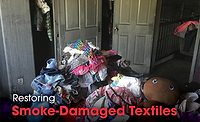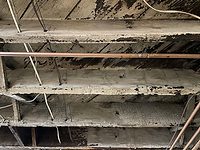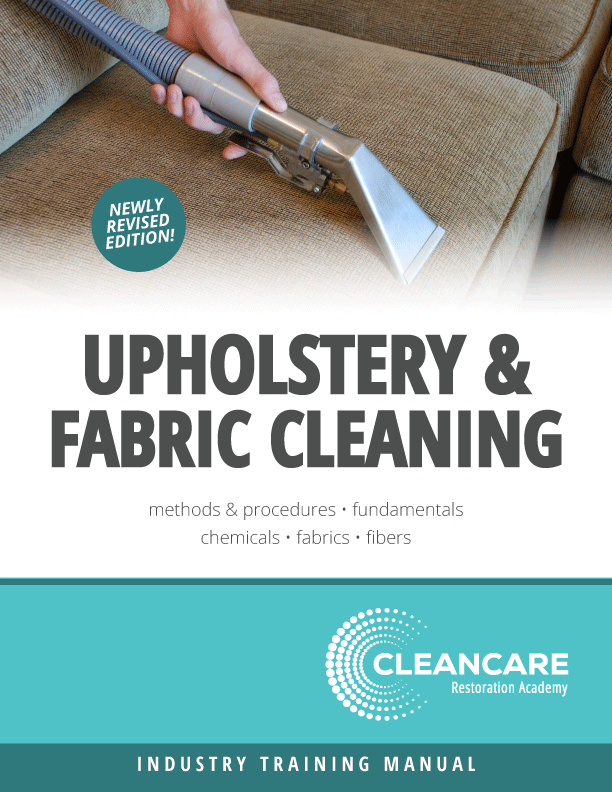Restoring Smoke Damaged Textiles: What Does Clean Mean?

Photo courtesy Sean Scott
Typically, after a fire where clothes are affected by smoke, insurance adjusters opt to have content cleaning companies remove the clothes from the premises and have them cleaned and deodorized. Then, once the home is rebuilt or restored, the “cleaned” clothes are returned and the life of the homeowner is supposed to be back to normal.
Being somewhat skeptical, I decided to conduct an experiment where I sent a couple articles of smoke damaged clothing to a leading textile restoration company to have them cleaned and deodorized. The articles were a pair of toddler’s purple polka dot pajamas and an infant’s red onesie. Both articles had been in a residential structure fire where a ground floor bedroom was completely gutted and the remainder of the home had moderate to heavy smoke damage throughout. Both articles were taken from a room that was furthest away from the fire source and both had a very strong smoke odor.
The following images show the actual experiment clothes before cleaning and deodorization.


Courtesy Sean Scott
Prior to accepting the clothes for cleaning, the textile restoration company assured me that they could completely deodorize and clean them. The articles were subsequently placed in an ozone chamber for 48 hours and then laundered. A few days later, I received the clothes back and they looked like new and had a pleasant-smelling detergent fragrance as one might expect.
The following images show what the clothes looked like after the cleaning and deodorization process.


Courtesy Sean Scott
Experiment Results: A Major Cause for Concern
Although the articles looked clean and smelled like what you might expect as a “clean” smell, I wanted to find out scientifically if the methods used to restore the clothes might tell a different story. So, I purchased a brand new baby outfit to use as a control. I submitted it and the smoke-damaged articles to a forensic laboratory that specializes in testing for chemicals and fire VOC’s to see if the combination of ozone and the cleaning processes truly restored the clothes, or if there were any VOC’s or chemical residues left behind that might be of concern.
About a week later, I received the analysis report from the lab and my suspicions were confirmed. My control article came back absent of any combustion byproducts or toxic chemicals, and the articles exposed to the fire contained an array of toxic combustion byproducts attributed to the fire, some of which were odorless. In addition, there were chemicals that may have come from the cleaning solutions, detergents, or the chemical reactions caused by exposure to ozone.
Here is the actual list of chemicals that were discovered in the smoke damaged clothing, many of which are known to be extremely toxic to human health from either inhalation or contact with the skin:

After I received the test results for VOC’s, I decided to perform one more test. This time I wanted to see whether any heavy metals might be in the fabric. Keep in mind that these results came after the clothes had been placed in an ozone chamber for 48 hours and then commercially cleaned by a nationally recognized textile restoration company.
Here are the metals that were discovered:

A layperson would assume that a nationally recognized restoration company that touts themselves as experts in textile odor cleaning and restoration, would use methods that would not only be effective, but safe once the processes were completed. In addition, you would also think that a piece of clothing that went through such a vigorous cleaning process would most certainly not have any hazardous chemical residues.
However, a wide range of chemicals were discovered and here are some – not all – of the health risks of exposure to the chemicals that were found in my experiment: irritation to eyes, skin, nose, throat and mucous membranes; serious or fatal poisoning; paralysis; coma; confusion; depression; respiratory failure; weak pulse; lung, liver, kidney, or pancreas damage; nausea; vomiting; diarrhea; abdominal pain; anemia; convulsions; blurred vision; increased risk of pre-term delivery in pregnant women; restlessness; vertigo; numbness; and headaches.
So, What Does Clean Mean?
Now, after reading all the health effects of exposure to these chemicals and metals, would you let your child wear clothes that had these contaminants in the fabric? I would venture to guess, probably not.
Then you have to ask yourself this: If you wouldn’t let a young child wear them, then at what age would you feel comfortable letting someone in your family or even yourself wear clothes that were contaminated with these materials?
If you look up the definition of the word “clean,” it reads: "free from dirt or pollution; unsoiled; unstained, free from foreign or extraneous matter; pure.” What you don’t see is any mention of scent. Scents are added to almost everything we use from cosmetics and personal care products to candles, cleaning products, hand soaps, laundry products and air fresheners. Somewhere along the line, "clean" has lost some of its meaning and has now become a scent when, in fact, the act of cleaning laundry or anything else is done to remove both soil and offensive odors.
So, how is "clean" supposed to smell? Simply put, clean laundry should smell like the absence of offensive odors. For most consumers, clean can also smell like your favorite detergent or fabric softener or any scent that reminds you of clean. This may be the smell of chlorine bleach or pine-scented disinfectant or some other scent.
Scientists in product research and development have zeroed in on scent clues to teach consumers the "smell of clean." Scented cleaning and laundry products tell consumers their efforts have been productive. If your laundry and home smell a certain way, then they are clean.
So why are heavy scents so common in laundry detergents? You might think it’s just because people like nice smells. But the truth is, traditional detergent companies use scents to cover up the odor in your laundry. They can’t actually clean out the stink, so they add fragrance. As the problem persists, you need more and more fragrance.
I am not a scientist, chemical engineer, or expert in microbiology, toxicology or chemistry. I am a fire restoration contractor who has spent his life in the construction and restoration industry, and simply wanted to verify some of the claims and methods accepted in the industry today. I asked the one question few have been willing to ask: Do the cleaning methods used today to clean smoke damaged textiles and soft goods really work?
The Takeaway for Restoration Contractors: Testing
The results of this experiment provide compelling evidence that restoration companies, insurance adjusters and consumers alike should carefully consider. Given my findings, I suggest before cleaning an entire home full of smoke damaged textiles, have a couple sample articles cleaned and then analyzed by an independent laboratory to see if the cleaning and deodorization process actually works. If the sample articles come back free of toxic chemicals and metals, then the cleaning processes are effective and the customer can rest assured that his or her clothes have been properly restored. However, if the clothes come back contaminated with hazardous chemical residues, VOC’s or heavy metals, then you may need to reevaluate the cleaning methods altogether.
So, what does clean mean in terms of restoring someone’s clothes or soft goods to a pre-loss condition? Is it even possible to clean and completely decontaminate smoke damaged clothes or textiles with today’s techniques? If the end result of using ozone and whatever cleaning chemicals that were used by the restoration company in my experiment leaves similar residues of toxic chemicals and metals, then the conclusion may be that smoke damaged textiles may simply have to be considered a total loss.
When homes or buildings are contaminated with asbestos, lead, mold, sewage or other hazardous contaminants, a testing laboratory will typically test the surfaces, areas, rooms and/or air after the cleanup is completed to certify that the restoration and cleaning processes were successful in removing the contaminants. This is commonly known as a final clearance test. Textiles, especially clothing exposed to fire or smoke related contaminants, should, without question, be subjected to similar testing to ensure they are clean and safe to use or wear.
Not having textiles tested after a cleaning could expose people to a wide range of chemicals and health risks. This could, in turn, expose restoration contractors and insurance companies to considerable liability.
Looking for a reprint of this article?
From high-res PDFs to custom plaques, order your copy today!








